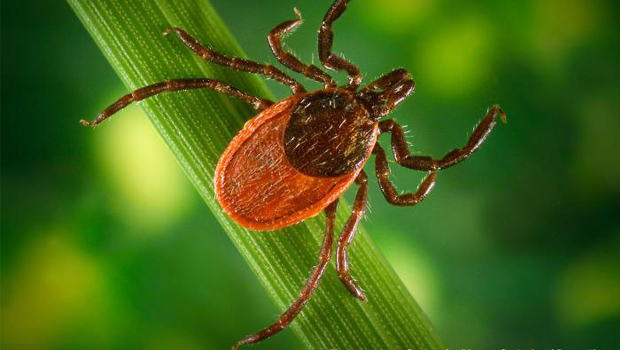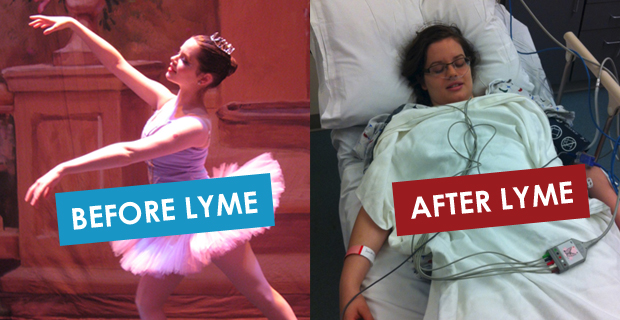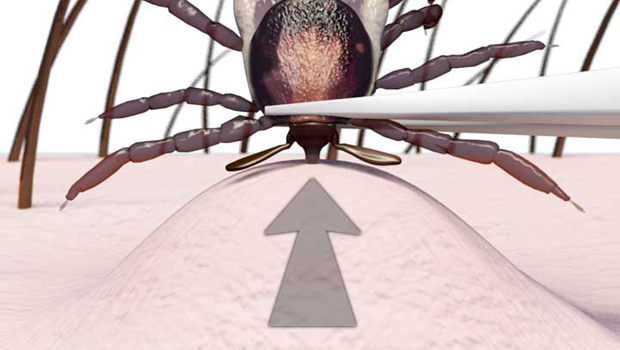
Two years ago my wife (then fiancé) was training six hours a day with a professional ballet company, working a part-time job, and planning our wedding. Six months later she was struck down by a debilitating illness that left her bed-ridden, in crippling pain, and suffering from severe neuropsychiatric symptoms. We are still fighting to get her health back.
The Centers for Disease Control reports that Lyme Disease — a serious bacterial infection transmitted by ticks — infects 300,000 people each year, representing nearly a 25-fold increase since national surveillance began in 1982.
Some of Lyme’s most notable victims include former U.S. President George W. Bush, Olympic athlete Angeli VanLaanen, and 30 Rock actor Alec Baldwin.

This month alone over 25,000 people will be newly infected with Lyme and other tick-borne diseases. Less than 50% will recall a tick bite or develop a characteristic rash. 40% will end up with long-term health problems. And 25% will be children.
Untreated Lyme disease can enter the central nervous system and every other organ system in the body, causing a diverse collection of symptoms including memory loss and cognitive impairment, sleep disturbance, psychiatric problems such as anxiety and depression, fatigue, heart problems, headaches, nerve pain and tingling, arthritis, and flu-like symptoms.
A recent survey of 3,000 patients with persistent cases of Lyme Disease revealed that these patients have a poorer quality of life than those suffering from chronic cases of congestive heart failure, fibromyalgia, diabetes, multiple sclerosis, or depression.
These sobering facts must be balanced by the encouraging news that adequate awareness and prevention, along with quick diagnosis and treatment have proven very effective in reducing the risk of developing chronic Lyme Disease.
The bad news? Awareness, prevention, diagnosis, and proper treatment are largely ignored by the general population — including the vast majority of family doctors.
This article is our attempt to spread the word about a devastating disease that has changed our lives. Please help us by sharing this post on Facebook, Twitter, Pinterest, and emailing the link to family and friends. Lyme Disease is a serious and growing threat. We can’t afford to remain unaware.
Who Needs to Worry About Lyme Disease?

The only people who need to worry about Lyme Disease and other tick-borne illnesses are outdoor-loving, camping fanatics who live in New England, right?
Wrong.
According to researchers at the University of Rhode Island, “there are more ticks in more places than ever before.” In fact, in the last ten years, ticks known to carry Lyme Disease have been identified in all 50 states and worldwide.
Connecticut, Rhode Island, New York, Pennsylvania, Oregon, Washington, California, Michigan, Minnesota, Virginia, Maryland, North Carolina, Alabama, Mississippi, Ohio, and Indiana all share the same Tick Encounter Index: HIGH — according to TickEncounter.org. And that’s only a partial list.
The point is: No matter where you live in the United States, Canada, or Europe, you are at risk for encountering ticks carrying dangerous and even deadly diseases.
A recent report in the journal Vector-Borne & Zoonotic Diseases revealed that tick-borne pathogens are not limited to rural and suburban areas, as researchers were able to collect infected ticks in the city as well.
As the weather grows warmer, millions of ticks have already come out of hiding. Depending on where you live, experts estimate there may be hundreds or even thousands of these blood-sucking insects right in your back yard (literally).
One afternoon last summer our family found over 50 larval ticks less than five feet from our front porch! If we hadn’t been looking for them, we would never have known they were there. Larval ticks are no larger than a fleck of pepper.
It only takes one tick to change your life. That is why awareness and prevention are so important. The good news is that there are simple, concrete steps you can take to dramatically reduce your risk of exposure to Lyme and other tick-borne diseases — without having to say “goodbye” to the great outdoors and retreat to an underground bunker.
5 Ways to Protect Yourself from Lyme Disease

- TICK-PROOF YOUR CLOTHES: Ticks generally start low and crawl up, either from the ground, tall grass, or shrubs. People who wear shoes and socks treated with Permethrin are 74 times less likely to be bitten by ticks than people who wear untreated shoes and socks. You can also treat your pants, shirts, hats, tents, etc. — further reducing your risk of being bitten. Clothes sent in to Insect Shield will repel ticks for 70 washings — the lifetime of the garment. Learn more at TickEncounter.org.
- IF POSSIBLE, AVOID TICK HABITAT: When on hikes or engaging in any other outdoor activity, be aware of prime tick habitat. That includes tall grass, leaf litter, and the edges of trails. Of course, certain people (e.g. landscapers, hunters, and adventure-bound children) may have trouble avoiding these areas. In those cases, treating clothing with Permethrin, checking for ticks, and other safety measures become more important.
- DO REGULAR TICK CHECKS: Even wearing tick-repellant clothing and avoiding tick habitat doesn’t completely eliminate your risk of exposure. When you come back inside, check yourself for ticks. They especially like below the belt, as well as belly-button, armpits, scalp, and around the ears. Remember, they can be smaller than a poppyseed.
- TAKE SHOWERS: Running water will wash off unattached ticks, so regular showers are a simple and extremely useful tool in protecting yourself against tick-borne diseases. However, showers will not dislodge ticks that have already attached themselves to your skin. That is why tick checks and other prevention tips are so important.
- PROTECT YOUR PETS: Dogs and cats that venture outdoors pick up more ticks than people. Not only can your pets get infected with tick-borne diseases, but they can also bring ticks inside your home. Protect yourself and your pets by using products like Certifect or K9 Avantix II.
What to do if you are bitten by a tick

If, despite these precautions. you are bitten by a tick, it is important to know how to remove the tick safely. Many folk remedies for removing ticks have proven to be ineffective and even increase your risk for infection. Never try to burn your tick, cover it with Vaseline, or simply wrench it out of your skin.
The safest way to remove a tick from your body is to use pointy tweezers (ordinary household tweezers may be too large and clunky to grasp tiny ticks). Clean the area with alcohol, then grasp the tick with the tweezers as close to the skin as possible and apply a slow, steady upwards pull in order to avoid breaking the tick. Once the tick is removed, disinfect the tick-bite area again with alcohol.
Save the tick in a container or bag labeled with your name, address, date, and estimated hours the tick was attached. The Tick-Borne Disease Alliance has a list of labs that will test your tick for Lyme and other tick-borne diseases.
When to Seek Treatment for Lyme Disease
The International Lyme and Associated Diseases Society (ILADS) — the largest medical body focused exclusively on Lyme Disease — advises that a “wait and see” approach to treatment may be risky.
Up to fifty percent of ticks in Lyme-endemic areas are infected with Lyme or other tick-borne diseases. With odds like that, if you have proof or a high suspicion that you’ve been bitten by a tick, taking a “wait and see” approach to deciding whether to treat the disease has risks. The onset of Lyme disease symptoms can be easily overlooked or mistaken for other illnesses. Once symptoms are more evident the disease may have already entered the central nervous system, and could be hard to cure. This is one case in which an ounce of prevention really is worth a pound of cure. — ILADS.org
ILADS provides many excellent resources for anyone concerned about possible infection with Lyme Disease and considering treatment. Start with their Top 10 Tips to Prevent Chronic Lyme Disease and then download and read their Evidence-Based Guidelines for the Management of Lyme Disease. They also can connect you with an ILADS-trained doctor in your area.
Where Can I Find More Information?

- If you do nothing else, take the time to watch the award-winning Lyme documentary Under Our Skin, which is available for free on Hulu.com. It is a fascinating and thoroughly educational look at the epidemic that is sweeping the United States.
- For our friends living South of the Mason-Dixon line, take the time to read Discover Magazine’s in-depth feature on Lyme and tick-borne diseases in the South.
- Websites like ILADS.org and LymeDisease.org provide reams of valuable information regarding diagnosis and treatment of Lyme and tick-borne diseases, while TBDAlliance.org and TickEncounter.org offer helpful tips for tick-bite prevention.
- Finally, if you prefer to get your information from a book, check out Cure Unknown: Inside the Lyme Epidemic — winner of the American Medical Writers Association Book Award and widely considered the definitive book about Lyme disease.
Lyme Disease and other tick-borne illnesses are a significant and growing public health threat that suffers from poor visibility and misinformation. This post is our attempt to bring greater clarity and practical solutions to the tick problem in the United States. But we need your help. This article can only help people who read it — and we believe everyone in America needs to read it. Please help us spread the word however you can. It could change someone’s life.
Share Your Thoughts in the Comment Section!
There are currently __ Comment(s)
There are currently __ Comment(s)










Thanks for writing this thorough article, Brett! God bless you and Ana and family as you fight for her health!
Thank you so much, Christopher! We’d really appreciate it if you’d be willing to share this in your circles online. We want to get it out as far and wide as we can. We really believe this information could change lives.
I will definitely do that!
Thanks so much! My little brother *loves* to be outside and he is like a tick magnet. We will be sure to look into some of the things mentioned, especially since we are under Mason-Dixon line. I will be praying for Ana too. 🙂
You’re very welcome, Annalysa! It is always heartbreaking for us to hear about children infected with tick-borne diseases. The good news is that children respond very well (and often very fast) to proper antibiotic treatment. The trouble is that parents and pediatricians often don’t catch these conditions and often misdiagnose them (even more so in the South than in the Northeast). If the disease is allowed to progress unchecked it can cause serious long-term health problems.
This is by far the best information I have yet read on Lyme’s Disease. Thank you so much for writing this and spreading the word! My family was just talking a couple days ago about how not enough people are well-learnt about the dangers of those itty-bitty bugs. Your article could not have come at a better time! I will have to show this to my friends, and especially my little brothers who, like Annalysa’s brother, seem to always be rolling around in something and bringing them in. 🙂 Thank you again, and I can echo everyone else in saying that I will be in prayer for Ana!
Thanks for the encouragement, Carolyn. We’re so glad the information can be helpful to people. An ounce of prevention really is worth a pound of cure when it comes to ticks!
Thanks for sharing this informative article! Something everyone should keep in mind is that normal insect repellant containing deet does not repel ticks. I was covered in deet when I was bitten by two lyme’s carrying ticks. Thankfully I soon found a rash and was quickly healed by antibiotics, but many are not so fortunate. Since then I have learned to research the type of repellant that I use to make sure it really is protecting me! Don’t just take the bottle label at its word.
Great point, Tanya. DEET is not a proven tick repellant. Permethrin is far superior for most species of tick, including the ticks most likely to transmit Lyme Disease. The other plus is that you don’t have to put it directly on your skin.
Thanks for sharing! Those close to me have dealt with this, and found it to be very serious and needing special attention. Tri Life Health has some great podcasts regarding this and other subjects. http://www.trilifehealth.com/podcasts/lyme-disease/update/ We found their clinic to be really helpful, and those that got their treatment are now very healthy. I hope Ana does well and returns to great health!
You’re welcome! We’ve definitely seen that more and more people (like you) have either dealt with tick-borne disease directly or had people close to them infected — and that number will continue to rise if we don’t raise awareness and take preventative steps.
In my area last year we had a large increase in our tic population. I trained almost daily on my bicyicle and would find 2 at the least to 8 at the most tics on my legs/shoes.
Not to prick apart your article, but you missed another area ticks often attack from. The trees! they are known to climb trees and drop from them straight on your head/shoulders. I have caught many of them trying to get to my scalp that way. Simple solution: wear a baseball cap when you’ll be in a forest or under trees, and they’ll be stopped. When you’re not under trees anymore it’s good to take your hat off and brush it off real good. Hope this helps! ~Grant
Thanks for sharing your story and your feedback, Grant.
Actually, from our research we’ve learned that ticks don’t actually drop from trees — even though it sure seems like it! Depending on the tick’s life stage and species it will quest anywhere from ground level to knee high. Once they attach they tend to crawl UP till they find a place to bite.
As creepy as it sounds, if you find a tick on your shoulders or head, it’s because it crawled over a lot of your body first!
However, you are absolutely right that wearing a hat is a good idea — especially one treated with Permethrin (which you can order on Amazon).
Oh thanks, that’s creepy. I must’ve heard an Old Wives Tale. Funny!
Don’t worry! I thought the same thing!
wow – we thought the same thing about
ticks and trees – that’s really creepy but a great thing to know! 🙂
What is Lyme disease https://www.youtube.com/watch?v=tX70ivbRyJ4
Roadmap to Reform http://www.jimapco.com/lyme/legisrecom.pdf
Hello Brett, Thank You so much for posting this very logical and informative read, my daughter was tested and diagnosed with Lyme Disease over a yr ago after many complaints and pleadings to her dr to find out whats wrong with her while suffering with it for over 3 yrs. It was reported to the CDC, but she is having a very difficult time finding a specialist that deals with it in her area (Denton, Tx) she has been battling with so many different symptoms that seem to randomly come and go frequently in rotation and can last for 2 weeks at a time or more, these combination symptoms are causing havoc and disability in her life. shes a wife, mother of 3 small children and college student. Shes really losing this battle because she has a doctor that is absolutely no help in finding a specialist, he tells her there are no specialist in the area or just poo poos her symptoms. Is there any advice you could give for her to get some sound treatment.
I’m so sorry to hear that, Edie! Unfortunately, your daughter’s situation is still far too common.
Have you tried contacting ILADS about doctors in your area? You can submit a request for information here:
http://ilads.org/fundraise/lyme-doctor/
At the same time, we chose to travel six hours once-a-month to visit one of the best Lyme doctor’s in the country. Given how sick your daughter is, we’d strongly recommend traveling as far as necessary to see a good Lyme doctor who has experience getting people better.
Thank You so much for responding so quickly, and for the contact info. I am definitely going to pass it and your suggestions along to my daughter, have Blessed day!
I appreciate you sharing this. I just shared it with my blog’s followers, and I certainly will try to be more careful outside. Also, I’ve been praying for Ana and you; please keep us updated!
Thanks so much Brandon! We live in the same neck of the woods — and let me tell you, there’s bajillions of infected ticks around here.
Incredibly well written article. THANK YOU Brett & Ana for sharing your story and for providing such helpful information. This truly is an article that every person in America needs to read. Oh Ana, I’m praying for you! I’m in the midst of hard battle against Lyme myself and was also a Ballet Dancer before Lyme hit…. Sending you many hugs & prayers. May Jehovah Rapha bless you with HIS healing and HIS strength in every cell of your body. God bless you both. ((www.lymehope.org)) ~Monica
Thanks Monica! We actually were just reading your blog before your commented and were so encouraged by your faith. We pray that God continues to strengthen you for this battle.
I am so sorry you guys have had to go through this. This is a wonderful article and I will be sharing it all over! I have gotten well enough to begin a support group in my city with lots of help, and our first meeting is next month. We would love it if you would pray for our group.
Thanks Holly! I’m glad your feeling well enough to start a support group. That’s a big undertaking for anyone, but especially for someone dealing with such a draining illness.
In case it would be helpful for your group, I’m working on laying out a PDF version of this article so people can print and distribute it. Keep checking back!
I’m trying to word this in a way as not to sound like I’m opposed to this, because I think it is really important to be aware of Lyme disease.But we also need to remember that there are other risks we take every day, such as getting in a car. I’m just trying to friendly remind people to be aware, but not to worry too much about it (as I try to do.).
Thanks Becca! That’s a really helpful reminder. And I think your example of driving in the car is a good one actually — because not too long ago people were really careless with automobiles!
Think about it. When cars first became popular people didn’t wear seat belts, the vehicles didn’t have airbags, and there were no speed limits or traffic lights! My grandma still remembers driving around town with her little kids walking around on the seat next to her! We’ve come a long way in learning how to enjoy the benefits of automobiles while mitigating the risks.
I think we need to make the same steps when it comes to tick-borne diseases. The solution is certainly not paranoia or never going outside again. But just like people had to adjust their behavior to get use to wearing seat belts for themselves and car seats for their children, we need to be willing to adjust our behavior to the new dangers we’re discovering outdoors.
Exactly.
I was thinking more about your comment, because I really think it brings up an important balance.
I was thinking about how car owners all buy car insurance, wear their seat belts, learn the rules of the road, and purchase often expensive car seats for their children. These activities are expensive and were probably inconvenient when they were first introduced. Now, however, we’re used to them, they are expected in our culture, and they have become automatic.
In the same way, I think that treating your shoes and clothes with Permethrin, checking for ticks, protecting your pets, and avoiding obvious tick habitat are inconvenient, but necessary. If we take the risks seriously and adopt these behaviors they can eventually become as automatic as wearing a seat belt.
At the same time, you’ll notice that most people aren’t paranoid about getting into a car accident — even though the risk is real. Instead, they simply habitually do a large number of things that minimize the risks of driving. Because of these safety habits, Americans are relatively safe behind the wheel and relatively stress free too.
I think the same thing can happen with tick-borne diseases. Unless we find other ways to eliminate the threat ticks pose, we will need to adopt numerous personal safety habits to minimize the risks of exposure. And these habits will be inconvenient at first — and then perfectly natural.
Most importantly, once we have adopted these habits, we really will be able to enjoy our lives without being constantly afraid of getting bitten. Just like we can drive on the freeway without constantly being afraid of getting hit.
Thanks again for such a helpful comment. It really helped me sort through some of these issues for myself.
I’m glad you understood my comment and that it helped you. Your comments have helped me as well. There is just one more thing I am worried about. Around here we are very ‘natural;’ we eat organic, examine ingredient lists, and make many of our own food and health care products. So this Permethrin has got me worried. So much of what we use on (and in!) our bodies is potentially harmful. Whatever we put on our skin does get inside our bodies. So I would really stress checking any side affects on this stuff and to check out more natural means of preventing ticks.
Wow, this is a well written and thought provoking article. It has certainly made me more aware of this threat.
What I didn’t know is that the ticks bearing lyme disease live in all 50 states. . . that certainly is creepy.
All in all we must trust in the Lord and pray that we won’t get the disease. Some might get it but everything is in God’s plan, whether we know it or not.
Brett, I hope the Lord guides you through these difficult times. I will be praying for your family. 🙂
God Bless,
Liam Siegler
Terrific article. Thanks for posting this guys!
Brett,
thanks for the reminder. I did want to put up a red flag I noticed in the post. Your picture in the start of the post of a ballerina was at least in my opinion slightly immodest. You may be laughing, but when you’re a 13-year-old guy struggling for purity, any picture of a girl’s bare thighs with a short skirt can lead places I don’t want to go. You probably didn’t even think twice about posting the picture, and I may be the only person in the universe who is bothered by it, but it might be good to consider that kind of stuff when posting.
Thanks for the post! I’ll take it to heart.
Sounds like you’re the person with the problem, not Brett… If you can’t deal with ballerinas maybe you should go live in a closet with only men. Don’t blame girl’s thighs for your purity issues.
Hannah, you’re assuming things I didn’t say in my comment.
I am in no way blaming Brett for the picture. Like I said, I may be the only person in the world bothered by that. I did not say I couldn’t deal with it-I dealt with it the same way I would deal with anything I found to be a temptation-by looking away. I commented simply because I thought Brett would want to know.
Also, while ballerinas are not the definition of sexual temptation (not even close!), little things like bare thighs and a short skirt or something like a low neckline can lead to bigger things, for me at least. I don’t think I’m the only guy in the world thinking what I said above either. I don’t think you understand this from our perspective, so I’ll excuse your comment that seemed to me unnecessarily harsh.
No, I’m not saying that the picture included was inappropriate. But I am saying perhaps what you think is totally acceptable and deem completely appropriate can be seen by others as inappropriate. Again, I don’t think that the picture was sexually inappropriate, but the view it pictured could lead to other things.
In the end, you’re a girl. It doesn’t really matter what you think is acceptable and fine and modest. What matters is the way guys view that. I think that instead of condemning me you should rethink what you said and perhaps come to a different conclusion on it. A girl’s thighs can in many instances be blamed for the starting of purity issues!
My biggest complaint with your post is the idea that you are blaming girls for guys’ inability to stay pure. I will wear whatever I feel comfortable in, and while I happen to wear fairly modest clothes, it is not my fault if a guy thinks dirty things if I wear a tank top and mid-thigh length shorts. Just like it’s not his fault if I think dirty things when I see a guy without a shirt. (Which I don’t.) Each person is responsible to God for their own thoughts. I don’t dress provocatively, but if I did, it still shouldn’t be my fault. Anyway, this is a weird conversation to be having on a page about the devastation of lyme disease so I’m done.
Why are you even getting at him for? He hasn’t done or said anything to provoke you to say that.
Your comment is offensive since you are blaming him for something you have no proof of him doing.
Please think about what you say and when to say it. I do agree with your ideas though. 🙂
God Bless,
Liam Siegler
Liam, I think the rest of kyle’s post has been hidden, I read it last night. ~Grant
Ohh, I didn’t see it. Ohh well, forget I said anything.
God Bless,
Liam Siegler
Very helpful info Brett.
Sarah and i praying for you and Ana.
Thanks so much Andrew! We love you guys!
Great article Brett! Thanks for the info. I went camping over the weekend and was frequently checking for ticks. I fortunately escaped any bites, the one tick that got on me was discovered on my pants leg, and quickly disposed of. (It helps to wear light colored pants so you can see the ticks better:) We have to check our cat often for ticks as well so that there’s less chance she will share them with us. I’m much more careful about ticks now that I know more about the diseases that they can carry. I don’t think it’s possible to know too much about this common issue!
By the way, I didn’t know your wife was a ballerina. Cool beans! (I took ballet lessons for a number of years:) It’s a great exercise, and lots of fun! I hope she continues to get well and strong again.
This is a very pertinent and well written article. So sorry for Ana’s journey with LD. I will share this on my blog – lymelifescapeswithcaroline.com
It is heartwarming to see your loving support towards Ana. I am also blessed with a husband who takes loving care of me.
We live in Northern California where we have an endemic population of ticks carrying Lyme Disease and other TBD. One test locally (the foothills of the Sierra’s) found that 40% of the nymphs carried Lyme. The coastal mountains has a very high rate too.
Here in the foothills, we have to watch out during winter when the ticks are more active; contrary to the East Coast where they have to be on high alert during the warm seasons.
One other idea that you can add to your resources in the article is the interactive map of Discovery magazine where you can plot on the map where you got infected and a short story about it. We want to spread the map so we can show the continent how many of us are infected and where we got infected.
I’m going to the May Day Project in Alexandria VA to protest outside of the IDSA.
Prayers for Ana and for you!
Caroline
One more thing – can you put a widget for WordPress? That would make it so much easier to share your articles. We have a big community on WordPress. Thank you!
Thanks, Brett! Definitely passing this on!
You guys might be interested in a blog a friend of mine is starting. She is a conservative homeschool-graduate who is now attending a liberal, public college. She is writing about the experience of often being the only conservative in a class of twenty or thirty people, and how that has forced her to grow and know why she believes what she believes. She is also sharing the humorous things that happen to her as a result of her situation.
elephantamongdonkeys.wordpress.com
I don’t know if y’all are interested, but I have been reading your blog for years and thought I would let you know about her writing.
Wow. I was bitten by a tick about 5-7 years ago. I am soooooo lucky it didn’t carry Lyme disease. I think, if it did, how my life would have been different. Anyone can be bitten by those freaky little nemesis-es. Is. Mrs. Harris doing better? I have been praying. Thanks for this article, Brett.
– Trent
This is a well written description of Lyme’s Disease! Thank you to Brett Harrris. I am a retired RN,BS who contracted Lyme’s 15 years ago. I was able to get 6 weeks of antibiotics (with some breaks in between, as most MD’s would only give 2 weeks worth) and appeared to be fine. Over the years, I have had arthritis which
continues to worsen. Now I am having fevers and sever joint pain in all joints.
This is not something to ignore! If you see a tick on you follow the procedures
for removing it, jar it, and take it to the MD with you! Follow all the the preventive
measures! Protect yourself and your loved ones.
First a disclosure: I am with Insect Shield, which is a commercial product mentioned in the article. That said this is a very insightful and thorough overview of the problem of Lyme disease, the tools and behaviors that reduce the risk, and the steps to take if you do find an attached tick. All of this information is well organized, artfully articulated, and (I am certain) well researched. Nice job.
Thanks for taking the time to leave a comment, Jason. We really appreciate Insect Shield and the amazing service you guys make available. We really believe that permethrin-treated clothing is the single most effective step people can take to protect themselves from Lyme and tick-borne diseases — and from our research there’s no better way to treat your clothes then to send them in to Insect Shield. All the best!
Thank you so much for the information about Lyme’s disease caused by ticks, especially now that I found ticks in our brooms, slippers, rugs and in curtains! I’m praying for your wife!
I think that number two needs to say, “Oh course, adventurous children and teens may have problems doing this.” Other then that, i think this is a great article!
I just learned of your wife having lyme disease. I am not only suffering and in treatment but my daughter’s as well. I’ve shared your story with my brand new son in law who is now truly realizing what he has become a part of as my daughter, his wife, has started treatment. Not only us my daughter house bound but the neuro-psych symptoms are intense. My son-in-law is a loving man of God who chose this journey despite his family advising him to wait until my daughter was better before marrying her. He has been encouraged by you and God directed us to your suffering on the day my daughter had her pic line placed. Thank you for using your platform to spread awareness! This disease is horrible, but even worse is the lack of understanding from those not infected. We have four of us in treatment and it is our faith in God that gets us through the worry of how to pay for treatment.
Dear Holly! I’m so sorry to hear what your family is going through. I would love to make myself available to encourage and support your son-in-law. I’ll shoot you an email with my contact information.
Thank you! My heart aches for him as he is realizing how hard this is going to be.
Oh Holly, bless your heart! I’m so sorry! I’ll be praying for your family!
Thank you Brett and Ana for your transparency in your sharing of your struggles with this terrible disease. Ana, please know that as a fellow sister in Christ, I’m praying for you!
Hey Jewel,
I just wanted to say, awesome profile picture. Funny enough, it is very similar to my blog’s logo. Just thought that was really cool. God bless,
– Trent
Hey Brett, could you delete the above comment. I have the feeling I could easily come across as trying to advertise with an obnoxiously large imagine. I don’t want to come across that way. So, if you wouldn’t mind…
Hey Trent, can you give me a link for your blog? 🙂 It’s encouraging for an approaching middle aged gal like me to see some young people coming up with a passion for God. I wish my daughter had more of that! She’s a Jr in high school… God bless:-)
No problem, Trent. I’ll leave it up. =)
Jewel, the link is: http://foreversoldiersofgod.blogspot.com
And thank you for your prayers for Ana!
You’re more than welcome & thank you for the link. I will continue to pray for the both of you. Althoughmy mmedical trial is different it is “invisible” where I have my good days & bad days. On the days I’m bedridden, I spend in prayerful communion with Jesus!
Brett, just saw this article, here’s the link:
http://lymedisease.org/news/lyme_disease_views/news-breakthrough-test-evaluates-drugs-for-lyme-treatment.html?utm_source=Nov+5+update&utm_campaign=new+drugs%3F&utm_medium=email
Hope it takes you to the article. It’s about a new breakthrough via Johns Hopkins. God Bless, Jewel
Let me know if it (the link) doesn’t work
Hi,
I live in Canada where there is no treatment at all for lyme. Doctors try to put you on depression medication because they think you are crazy. I finally paid to have a blood test done at Ignex labs and the test came back positive. I have had symptoms since I was a little girl. My symptoms include intense pain in all muscles and joints,seizures,headaches,bone cracking,panic attacks and many more. I have been told by many christian that this is a spiritually roots disease. What do you think about this? I have no treatment options so I am literally just trusting in the Lord to heal me. I am a young mom of two daughters and my husband works hard to support our family but we can not afford the cost of traveling over the boarder for help :(.
Your wife is so blessed to have a family that is looking after and has treatment available to her. I feel terribly alone and like I am just waiting to die Praise the Lord that I am able to look after my daughters so that my husband can work. God is good and I can’t wait for an eternity with a perfect heavenly body:)
Julia, I am so very sorry for all that you are going through. I have had Lyme for 10 years, but was diagnosed 3 years ago. This is definitely, by NO means, a spiritual rooted disease! My goodness! Perhaps because doctors there have diagnosed you with depression, and many people believe all depression to be spiritual…which it’s not. I pray that God blesses you and covers you with His mercy and favor; giving you strength for each day, and His healing touch.
I’m so sorry that you have to deal with all of this! Those people who tell you that it’s some sort of spiritual “punishment” probably aren’t close to the Lord. I know that it doesn’t seem like it, but God really does use everything for good. I’ll pray for you, Julia!!!
This is a really good reminder about ticks and how dangerous they are! In the past I hadn’t really known why they are so dangerous, but recently I have learned more! I know a family in our church in Canada who is trying to raise money to get treatment in the US for lyme disease, because Canada doesn’t have treatment for it.
Many in our family have had lymes. Our chiropractor has developed herbal tinctures that are very effective in treating it naturally. Check it out at https://www.facebook.com/lindsleychiro
I should not have read this right after dinner
Thanks so much for posting this! Quite a few years ago my mom was diagnosed with chronic lyme disease. Fortunately she rarely suffers from the symptoms of it; only when she gets overly stressed or exhausted.
We use Permethrin on our yard and clothes and have found it to be extremely successful in keeping ticks away.